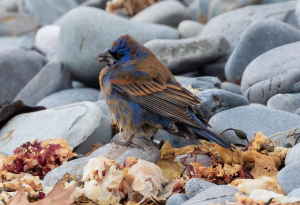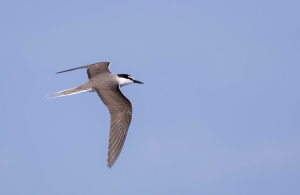Welcome to fall migration season 2019 for BirdCast! Our 3-day forecast maps have returned, and our migration maps are live, so you can check predictions for and monitor nightly migration intensity through the fall season. Please visit us often! Read more...
Welcome MistNet, a deep convolutional neural network to discriminate precipitation from biology in radar scans! MistNet is a tool that can enable large‐scale, long‐term, and reproducible measurements of whole migration systems, a hallmark of developments by our collaborators at University of Massachusetts and the BirdCast team. Read on to find out more about today's paper published describing this exciting new tool. Read more...
19-22 April 2019 saw some spectacularly intense weather in the eastern US, with some obvious after effects in terms of migrating birds' distributions. Read on for a brief description of events that presumably carried nocturnally migrating songbirds farther afield that they intended to travel. Read more...
The BirdCast team has been busy publishing science! We have been very fortunate to publish a number of papers over the past year to document all the cool findings we've discovered in our work and with our collaborators. Here is a short summary of some of them, with links to where you can read more. Read more...
Special issue on Radar Aeroecology As you know, one of the main methods we use to study birds here at BirdCast is radar. Radar has been used to study animal movements for a long time, but recent advances has greatly increased its use and lead to a new wave of research and applications of radar […] Read more...
Global Big Day is nearly here, and Team BirdCast wishes all of you birding around the planet an exciting, safe, and diverse day! For those teams birding in the US, we have a special addition of Species on the Move ... Good luck to all! Read more...
Global Big Day is almost here, and here's another Species on the Move that teams in Eastern Asia may hope to find! Read more...
Migration is well under way across the globe, and Team BirdCast is highlighting a few species in interactive maps made with eBird data. Check out how the progression of migration for the group of species has changed over the last 30 days. Read more...
Since its beginnings, BirdCast has been fortunate to receive media attention from a diverse array of outlets. We’ve assembled some of these below in this post to keep you all updated on the outreach and education. Some of the links are more directly related to our work with radar and aeroecology, others more closely to […] Read more...
ANN ARBOR—Birds that produce faint chirps called flight calls during nighttime migration collide with illuminated buildings much more often than closely related species that don’t produce such calls, according to a new analysis of a 40-year record of thousands of building collisions in the Midwest. The new analysis of more than 70,000 nighttime songbird collisions in […] Read more...
Chicago, Houston, and Dallas top the list Ithaca, NY—An estimated 600 million birds die from building collisions every year in the United States. Scientists at the Cornell Lab of Ornithology have published new research highlighting artificial light at night as a contributing factor. They’ve ranked metropolitan areas where, due to a combination of light pollution and […] Read more...
New research from the BirdCast team highlights risks of exposure to artificial light at night for migrating birds. We ranked metropolitan areas where birds are at the greatest risk of becoming attracted to and disoriented by lights. Read more...
With the vernal equinox approaching, Team BirdCast welcomes back our forecast and live migration maps for the spring 2019 season! Read more...
Data from radar & bird watchers reveal spring migration details Ithaca, NY— A new study combining data from citizen scientists and weather radar stations is providing detailed insights into spring bird migration along the Gulf of Mexico and how these journeys may be affected by climate change. Findings on the timing, location, and intensity of these bird movements are published […] Read more...
New study finds both positive and negative impacts possible Ithaca, NY—Under future climate scenarios, changing winds may make it harder for North American birds to migrate southward in the autumn, but make it easier for them to come back north in the spring. Researchers from the Cornell Lab of Ornithology came to this conclusion using […] Read more...
Hurricane Michael strengthened rapidly into a major hurricane on Tuesday, and as with previous storms on which BirdCast reported, it may have dramatic impacts on local and transient bird communities and their habitats when it comes ashore and passes through the Southeastern US. Live sightings will appear on the current observations map as they are entered into eBird, but as always, for those in the path of this storm, safety first! Read more...
Real-time sightings from your eBird checklists will appear in this post's map, providing a unique opportunity to help us understand how these storms transport birds and how birds respond to extreme disturbances in their annual cycles. Read more...
4 Billion Birds Will Fly Through American Airspace This Fall By Carley Eschliman From the Autumn 2018 issue of Living Bird magazine. Subscribe now. Fall migration will bring 4 billion birds into the skies over the United States. That’s not a guess—it’s hard data, gleaned from the first-ever national bird count using weather radar. Cornell […] Read more...
Researchers predict the movements of millions of birds across the United States Ithaca, N.Y. & Oxford, U.K.—September is the peak of autumn bird migration, and billions of birds are winging their way south in dramatic pulses. A new study published in the journal Science reports that scientists can now reliably predict these waves of bird migration […] Read more...
Hurricanes and their impacts, in particular in depositing seabirds far afield from their normal haunts, represent unique opportunities to understand how animals behave in and respond to serious disturbances. Hurricane Florence is no exception. Read more...














